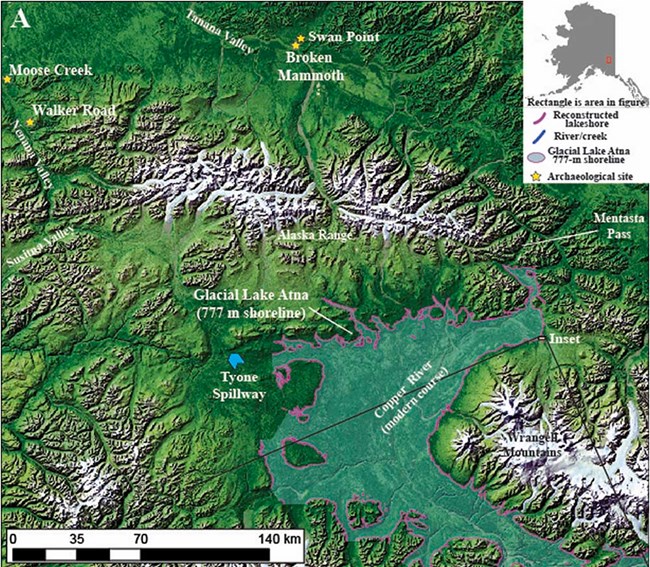Last updated: October 21, 2022
Article
What we are learning from Nataeł Na’

Results from excavation of the Nataeł Na’ archaeological site indicate the earliest known human occupation of the eastern Beringia south of the Alaska Range (about 13,100-13,000 cal BP). The Pleistocene settlement was located in the ice-free Copper River valley along the shores of Glacial Lake Atna.
The findings from the site represent an exciting new discovery that demonstrates the potential of the Copper River basin for the study of early Beringian archaeology and paleoecology. Artifacts expand our understanding of the early Alaskan archaeological record compared to other known sites. The location and timing of occupation suggest that the climatic changes during that period were not the initial motivator for human populations to move into and south of the Alaska Range. The findings here will contribute to knowledge of human movements along the north Pacific corridor.
Terminal Pleistocene human occupation of the upper Copper River basin, southern Alaska: Results of test excavations at Nataeł Na’
Abstract
After decades of debate, the homeland of the First Americans is now generally understood to be northeast Asia; however, the process of Late Pleistocene peopling remains unresolved. As more archaeological sites south of the continental ice sheets are discovered that predate the opening of the interior “ice-free” corridor, interest in a coastal Pacific dispersal route has grown, and previously overlooked regions proximal to the Pacific coast have become a central focus of exploration efforts. The Copper River basin of southern Alaska is one such region. Here we present the results of 2019 archaeological excavations at Nataeł Na’, a buried and stratified archaeological site situated along the upper Copper River. The site contains a robust occupation dating to the late Younger Dryas climate reversal as well as an earlier occupation dating to the late Allerød interstadial. This discovery demonstrates that Pleistocene hunter-gatherers inhabited the Pacific basin of southern Alaska during the same time Clovis peoples inhabited temperate North America. The occupations at Nataeł Na’ join a growing body of evidence suggesting that the early inhabitants of eastern Beringia were geographically more widely dispersed than previously documented.
White, J. T., A. Henry, S. Kuehn, M. G. Loso, and J. T. Rasic. 2022. Terminal Pleistocene human occupation of the upper Copper River basin, southern Alaska: Results of test excavations at Nataeł Na’. Quaternary International.
